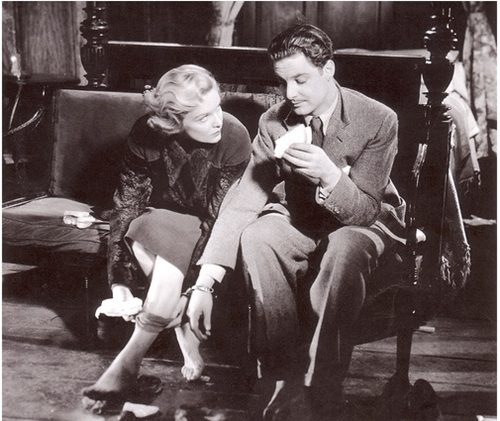By Michael Wilmington & Film Noir Blonde
The Noir File is FNB’s guide to classic film noir, neo-noir, sort of noir and pre-noir on cable TV. All movies below are from the schedule of Turner Classic Movies (TCM), which broadcasts them uncut and uninterrupted. The times are Eastern Standard and (Pacific Standard).
PICK OF THE WEEK
“His Girl Friday” (1940, Howard Hawks). Sunday, Jan. 27, 2 p.m. (11 a.m.)
At a Hollywood party, director Howard Hawks decided to prove that Ben Hecht and Charles MacArthur’s racy, breezy, brilliant Chicago newspaper play “The Front Page” – about corrupt politicians and cynical newsmen covering an execution – had the best comic dialogue ever written. Hawks picked up a script, started reading the lines belonging to double-dealing editor Walter Burns. He handed the other script, and the part of ace reporter Hildy Johnson, to an actress at the party. “My God,” Hawks said after a few salty, rapid-fire exchanges, “It’s better this way than it is with two men!”
So Hildebrand Johnson, a part for Pat O’Brien in the 1931 movie of “The Front Page,” became Hildegarde Johnson, a great part for Rosalind Russell in 1940 – not only Burns’ star reporter, but also his leggy ex-wife. Meanwhile, Walter Burns (Adolphe Menjou in 1931) became a great part for Cary Grant. And “The Front Page,” thanks to Hawks, became “His Girl Friday,” the best ’40s noir comedy, with the best and fastest American comic dialogue.
In the 1931 movie of “The Front Page” (directed by Lewis Milestone), Menjou and O’Brien bat around the blistering Hecht lines with almost jaw-breaking speed and rat-a-tat overlap. In Hawks’ gender-bending remake, those terrific lines get even more overlapping virtuosity, supplied by the cool Grant and the hot Russell. Equally memorable was the actor who replaced Mary Brian as Hildy’s fiancé, the yokel husband-to-be Bruce Baldwin – the guy whom Cary describes at one point as “looking like that actor, you know, Ralph Bellamy.”
Wednesday, Jan. 23
4:45 p.m. (1:45 p.m.): “The Body Snatcher” (1945, Robert Wise). With Boris Karloff and Bela Lugosi. Reviewed on FNB Oct. 27, 2012.
Thursday, Jan. 24
8:15 a.m. (5:15 a.m.): “Bad Day at Black Rock” (1955, John Sturges). With Spencer Tracy, Robert Ryan and Lee Marvin. Reviewed Sept. 7, 2012.
Friday, Jan. 25
12:15 a.m. (9:15 p.m.): “Ocean’s Eleven” (1960, Lewis Milestone). Frank Sinatra, Dean Martin, Sammy Davis, Jr., Peter Lawford and Joey Bishop – the gang of elite show biz chums variously known as The Clan, The Rat Pack and The Summit – pull a super-heist in Las Vegas. (Shirley MacLaine does a cameo.) OK, but it could have used more songs. (Dino and Sammy sing; Frank doesn’t.)
Sunday, Jan. 27
8 p.m. (5 p.m.): “The 39 Steps” (1935, Alfred Hitchcock). With Robert Donat and Madeleine Carroll.
9:30 p.m. (6:30 p.m.): “The Lady Vanishes” (1938, Alfred Hitchcock) With Michael Redgrave, Margaret Lockwood and Paul Lukas.
11:15 p.m. (8:15 p.m.): “Sabotage” (1936, Alfred Hitchcock). Hitchcock’s version of Joseph Conrad’s “The Secret Agent”: Marital problems among a couple who manage a London movie theater (Sylvia Sidney and Oscar Homolka), lead to espionage and terrorism. The film contains one of his most ingenious and terrifying suspense sequences.
2:30 a.m. (11:30 p.m.): “Mafioso” (1962, Alberto Lattuada). A taut dramatic thriller: A hapless Italian immigrant and worker (Alberto Sordi) in the U.S. is recruited by the Mafia for a job in Sicily. In Italian, with subtitles.



































![Bonjour Tristesse DVD[1]](http://www.filmnoirblonde.com/wp-content/uploads/2012/11/Bonjour-Tristesse-DVD11.jpg)














From FNB readers